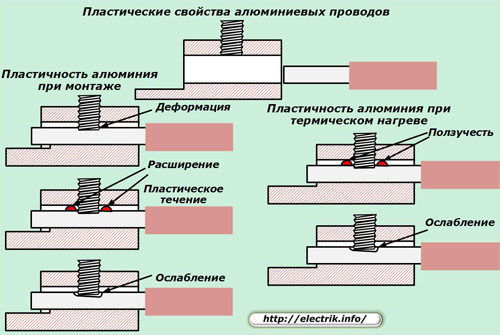Categories: Electric installation work
Number of views: 24203
Comments on the article: 4
How to install hidden electrical wiring in the home
The owners try to create most of the modern living quarters with perfectly aligned walls, floors and ceilings without unnecessary protrusions, and all electrical communications are hidden inside building structures. This allows you to create a unique design, restricts access to wiring, but complicates its inspection and maintenance.
The technology for installing hidden electrical wiring can be performed in various ways, which are constantly being improved with any method of building construction. For each particular case, choose the best option that meets two basic requirements:
-
reliability of work;
-
safe operation.
The installation cost should also be taken into account, but it should not be considered at the time of wiring, but should be considered in conjunction with the possibility of a long, safe operation, eliminating the occurrence of malfunctions, emergency situations, including the consequences of their elimination.

Hidden wiring diagram
Its presence is a mandatory attribute before starting electrical work. Design organizations create documentation at a professional level, take into account the rules of safe operation, the necessary protection, specific requests of the owner.
The independent drawing up of a closed wiring diagram without proper experience can complicate the work, lead to excessive waste of material resources, the creation of serious errors for which electricity punishes.
Experienced electricians can do it yourself. A separate subject is dedicated to this issue. article on creating an electrical wiring diagram in an apartment. We recommend that you carefully read it.
Wiring Route Requirements
In hidden wiring, current-carrying cable conductors and wires must provide two functions:
1. current flowing through the elements of the electrical circuit with minimal power loss and voltage drop;
2. reliable insulation of the formed chains between themselves and the earth circuit, eliminating the occurrence of short circuit currents and leaks.
Wire selection for metal core
To solve the first problem, trade provides the consumer with the choice of wires and cables with metal cores from:
-
aluminum;
-
or copper.
The advantages of aluminum conductors include:
1. less weight;
2. reduced cost.
However, they have disadvantages:
-
underestimated mechanical strength, providing a break after several bends, twists and tensions;
-
increased ductility of the wire in the clamped terminal. When it is heated from the current load, an additional deformation of the metal occurs due to the expansion of the contacting steel parts. After cooling, the steel returns to its previous size, and aluminum remains in a reduced size. The contact weakens, and the resulting oxide film layer on aluminum further worsens the electrical resistance at the junction, which leads to overheating, sparking, fire, fire.
In closed modern wiring, even at rated loads, high heating of the wires is created. Heat removal from them to the external environment is limited. Plastic and weak aluminum in such conditions is prone to malfunctioning, is prohibited.
Choose copper.
Dielectric Insulation Properties
The outer sheath of current-carrying conductors can have one dielectric layer on the wires or several on the cables.
Trade provides cable products designed to transmit electrical energy of different voltages from low-current circuits of several tens of volts to high values measured in kilovolts.
In a household network, it is enough to use conductors with insulation withstanding 0.4 kV. They cope well with the loads that arise during short emergency situations associated with overvoltages in the power supply circuit, which are eliminated by appropriate protection.
However, when choosing a cable, you should pay attention to its fire-fighting qualities. In a closed version, the wiring can be subjected to high temperature loads. It must have non-combustible properties.
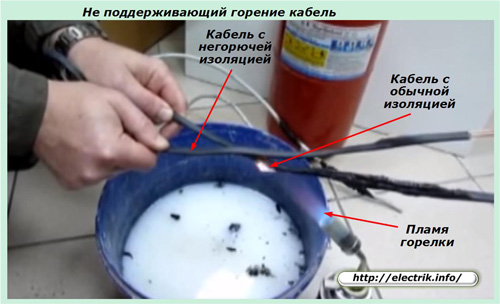
This parameter is indicated in the marking with the symbols “ng”, for example, VVGng 3x1.5 cable. Simple insulation of conductors during overloads in the network can ignite, sustain combustion, and cause a fire.
About flat wires PUNP, APUNP
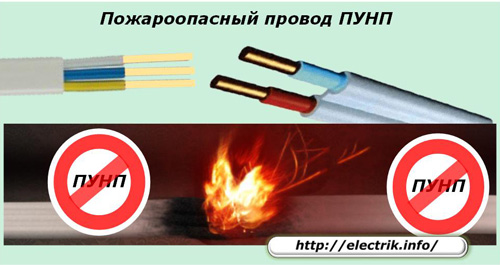
Cable products of this brand, which stands for flat wire with universal properties (the letter "A" means aluminum inside the conductive core, not copper). PUNP wires have long become a household name.
They are issued not according to state standards, which are the law, but according to the local technical specifications “TU” of the manufacturer’s enterprise. The cross section of the conductors indicated on the factory label may be reduced to 30%. The insulation layer from low-quality materials is also underestimated.
Even with a double insulation sheath, PUNP wires do not meet safety requirements and are the cause of numerous fires in household wiring.
The use of PUNP and APUNP brand wires in household closed or open wiring creates increased risks to people's lives and property safety.
Directional trunking directions
Among electricians, a rule has long been made to uniformly orient wires inside building structures with maximum compliance with horizontal and vertical lines located at right angles. They correspond to the main directions of architectural designs.
This technique facilitates troubleshooting in enclosed wiring, allows owners to better navigate the walls when mounting fasteners for furniture and accessories.
Features of wiring in panel buildings
In old houses made of reinforced concrete panels, the method of arranging wires horizontally and vertically was previously often violated in order to save materials. In the plates for walls and ceilings during their casting, special tubeless voids and indentations were created for laying electrical mains. These channels were located at arbitrary, but typical angles for the entire series of buildings.

It is not required to deal with the marking of the installation sites of electrical appliances and cabling with this method. At the joints of building structures, recesses are created for connecting electrical wires. At one of the wall panels, niches for the placement of an apartment electrical panel and low-current circuits have been prepared.
You can get acquainted with a similar arrangement of cable lines in the construction technical documentation or clarify the passage of routes from neighbors or service electricians.
When pulling wires in such channels, the cross section of their free space is checked by pulling a caliber, as well as the absence of cutting edges that can damage the outer insulation when cable is being wound.
The pulling force of the wires into the prepared cavities is limited to 20 N per 1 sq mm of the total cross-sectional area of the conductors used. When the free diameter of the channel is 20 mm, it is permissible to place 5 wires with a cross section of 2.5 mm square in it, and for 25 - 8.
Features of the installation of electrical wiring in buildings of building blocks and bricks
Flush mounting is associated with the implementation of a large amount of dirty, dusty work on the processing of wall material and building structures. It is better to carry out before finishing the premises.
The work begins with the marking according to the design scheme and the execution of electrical points - places where the cables are connected to the wires and placed sockets, switches, lighting fixtures, junction boxes, panels and other electrical equipment.
Then, all electrical points, starting from the entrance or apartment panel, are marked with cable laying lines between the electrical points. According to the markup created, recesses in building structures.
For indoor installation in a plastered wall, the cable can be placed inside the bonding joints, under a layer of plaster or in prepared strobes.
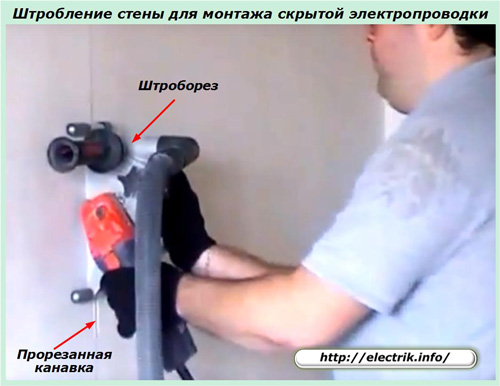
When gating, pay attention to the thickness of the wall and the required depth of its processing. You must not go beyond permissible boundaries. Otherwise, weakening of building structures occurs, which can cause the collapse of the supporting element.
It must be clearly understood that the gating of power bearing structures and ceiling plates is not allowed, is prohibited.
Cable can be placed:
1. into a pipe or corrugated sleeve, which is puttied directly into the shtroba;
2. or mount without it.
In the first case, it becomes possible to quickly remove from the corrugation damaged in this section of the cable and replace it with a new piece. In the second embodiment, a non-separable connection is formed, which requires the repair of dirty work.
However, with the right choice of cable with additional protection for the sheath from mechanical damage and the exclusion of emergency operation modes, the second method is economically justified. It is most often applied in practice.
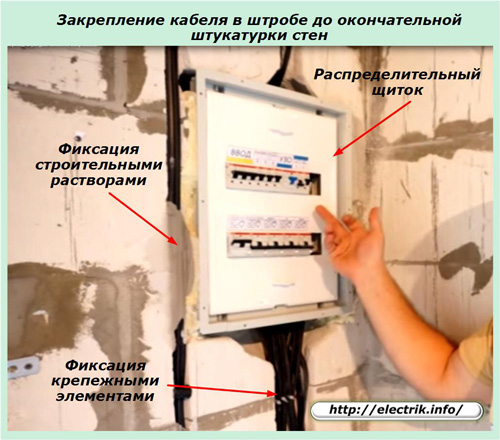
But, in this case, first do local fixation of the cable inside the strobe, for example, with gypsum or alabaster, and then perform the final electrical installation of the circuit, check the quality of its work. After eliminating the errors that have occurred, finish the plastering of the cut line.
Concealed wiring on drywall partitions
Plasterboard sheets are used for leveling walls, dividing rooms into zones, creating suspended ceilings and multi-level structures. They install sockets, switches, light sources.
The technology for mounting wires and cables in this situation is less labor intensive. Strobes do not need to be done. All communications are hidden behind a sheet. At the same time, attention is paid to the exclusion of damage to the outer insulation layer when mounted on reinforced metal structures for attaching drywall. Otherwise, leakage currents and the appearance of a dangerous phase potential on the mounting device may occur.
The best option for protection is the placement of wires inside a corrugated pipe, mounted on metal profiles and protecting the layer of external insulation.
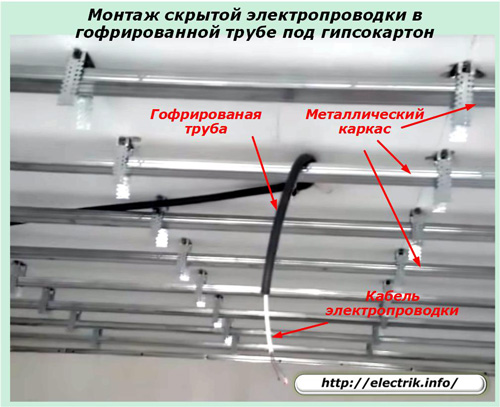
Concealed wiring in wooden buildings
Now construction companies mass-produce houses from logs, glued and rounded timber. They are in demand due to natural environmentally friendly materials, and the owners want to have all the conveniences of modern civilization and want to operate the electrical wiring installed in a hidden way.
Performing such a plan, three important conditions must be observed:
1. wood, even impregnated with special fire-fighting compounds, is a combustible material. If the wiring is damaged, sparks or an arc occur, causing a high temperature, which the impregnation layer cannot withstand - a building fire is inevitable;
2. wood products in their structure contain moisture, which dries or accumulates during operation. In the first few years after construction, houses reduce their size - they shrink;
3. At low temperatures, condensation forms in the internal ducts for the wires.
We will analyze them in more detail.
1. How to protect wood from fire in hidden electrical wiring
On this issue, clause 7.1.38 of the current seventh edition of the EMP clearly defines three important points for our case:
1. carry out hidden electrical wiring exclusively inside metal pipes and ducts with localized ability to ignite;
2. Use only non-flame retardant cables;
3. realize the possibility of replacing damaged cables.
Features of the cable fence from wood
The rules of the PUE unambiguously indicate a method for performing flush mounting of electric mains in environments capable of fire, focusing on the fact that the cable's protective enclosure should prevent the development of fire and localize it.
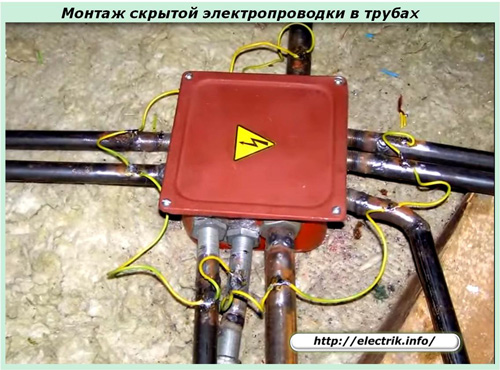
The fact is that the wiring can be operated with overload, when protective devices do not have time to eliminate it yet. In this case, the insulation is subjected to small but irreversible processes, gradually worsens its dielectric properties.
As a result of its premature aging, a short circuit occurs over time, an electric arc is formed with a temperature of the order of five thousand degrees. She instantly burns the outer shell. If the cable is located near wood, the latter ignites.
When the highway is hidden inside a wooden wall and a fire starts, it is very difficult to extinguish it because the fire is hidden, it is problematic to get to it with simple fire fighting means. The situation is exacerbated by the accumulation of dry wood dust, which in an explosion ignites along the entire length of the highway. When the fire flared up well and burst out, it immediately covers most of the structure.
Therefore, the cable must be protected from wood reliably. Since the corrugated sleeve burns out due to high temperature, like the thin-sheet pipes, it makes no sense to use them.
In electrician forums, there is controversy over this issue. But, in case of a short circuit, the cable enclosure must withstand the temperature flash of the created electric arc, exclude the burning of the metal protection, and therefore - ensure the integrity of the volume.
Then there will be no inflow of fresh air to the place of ignition, and the fire of the electrical wiring is self-destructing due to the lack of oxygen, as an oxidizer of the combustion process.
It is important to focus on the fact that the metal channel with the cable must be reliably sealed against ambient air. Otherwise, self-extinguishing of the fire is excluded. To this end, separate pipes are interconnected in advance in one of two ways:
1. welding;
2. sealed threaded connection.
In the second case, it is necessary to provide electrical connection between the individual pipes. After all, the entire metal pipeline will also need to be connected to a protective grounding device in a potential equalization system to exclude sparks or breakdown.
Cable entry into switchgears, junction boxes, sockets and switches is also sealed, and they are installed in a metal socket.

Features of flame retardant insulation
Since the current of the electric arc of a short circuit is of the same nature as that of welding, it is proposed to conduct a simple experiment with two pieces of cable with conventional insulation and not supporting combustion: to expose them to high temperature.
As a result, you will see that in both cases the external protective coating will become burned through. But in one case, the insulation will continue to burn, and in another it will stop.
This will help to understand that a cable marked “ng” does not protect against short-circuit emergency current short circuit, but only does not exacerbate the fire. Its insulation is destroyed and requires subsequent replacement.
The ability to replace damaged cables
This requirement of PUE also complicates the installation of hidden electrical wiring in a wooden house.In the design of the metal pipe, it is necessary to provide hermetically sealed windows through which the faulty cable is removed and a new one is mounted.
Without the technical implementation of this feature, a clear violation of the rules of the electrical installation is created.
2. Taking measures to protect the hidden electrical wiring from building shrinkage
The building, built of wood with natural humidity, can dry out and settle down to 15 ÷ 20 cm in 3 years on one floor at its height of about three meters.
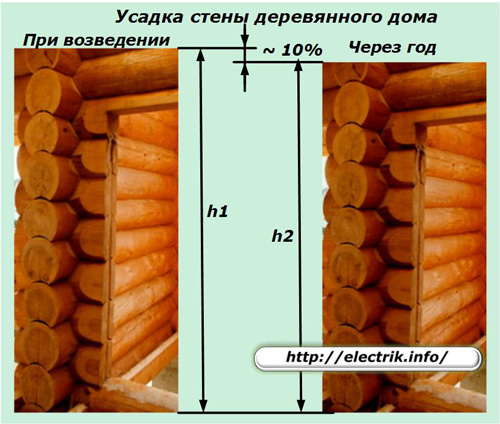
The thick-walled metal pipe mounted inside the wall will not change its dimensions. It will be affected by external mechanical loads of adjoining building materials.
To eliminate the pipe deformation, it will be necessary to introduce compensating devices into its design, which will eliminate the vertical compression forces, prevent the destruction of the sealing of internal cavities and violate the integrity of the cable.
The technical implementation of this method in each particular case requires calculation and justification.
3. Taking measures against condensation
Let's say that we created a house from glued beams in which we want to preserve the natural color of natural wood and therefore emphasize its natural appearance with various design techniques from the inside. Under the rules of the PUE, hidden electrical wiring was placed inside the walls, placing it in sealed metal pipes and even provided devices that compensate for the shrinkage of the building.
If the house is located in a warm area, where low temperatures are excluded, then this can calm down. When in the winter the temperature drops to minus 25 degrees or lower, condensation will appear in the metal pipe with the cable, caused by the temperature difference on the external and internal sides of the walls.

Moisture from it will flow from top to bottom where the sockets and switches are located. With an increase in the thermal difference, its amount will increase. Upon reaching minus temperature inside the pipe, the accumulated water will turn into ice.
To prevent the formation of condensate, it will be necessary to apply a layer of thermal insulation on the external and internal sides of the wall. How efficiently it will work remains a question, but the design intent for wall decoration with natural wood will have to be violated.
It remains to consider the option of installing hidden electrical wiring only in the internal walls or to think through other technical solutions, for example, placing it in the floor and raising it to a small height to outlets.
As a result, it turns out that for a wooden house it is possible to carry out safely hidden electrical wiring only in compliance with all the requirements of the PUE. However, for this it will be necessary to provide for the issues of shrinkage of the building and prevent the formation of condensate in the winter.
Violation of any of the above safety requirements, of course, will not immediately lead to a building fire. But the owner must clearly understand that an accident in the electrical circuit can occur at any time. Automatic protections prevent it not instantly, but with the smallest possible time delay. The breaking of the load current is often associated with the formation of an arc, the flame of which is not extinguished immediately.
Dried wood is quite easily ignited from damage in the wiring. To live in a house built with violations of existing rules is to put yourself at risk, to repeat the path of those who have already experienced the effects of a fire.
It is possible that the author’s opinion on the design of closed wiring in a wooden house is erroneous and can be made much easier ... Try to convince in your comments, express your arguments.
Installation of hidden electrical wiring in the home after it is completed inside the house from any materials must be inspected and checked before electrical connection by electrical measurements:
-
the compliance of the assembled circuit with the continuity of the sections of the mounted circuits;
-
measuring insulation resistance with a megohmmeter between all phase and zero wires, and also to the ground loop.
Without measurements, short circuits and leakage currents are possible, which will appear due to the mistakes made immediately when the assembled circuit is turned on under load.
See also at bgv.electricianexp.com
:

